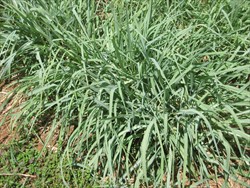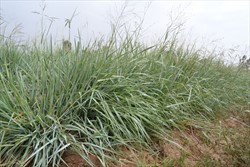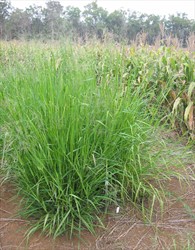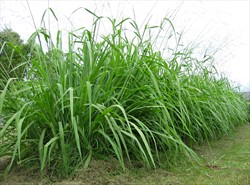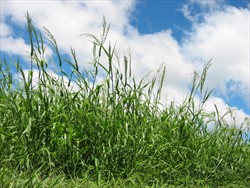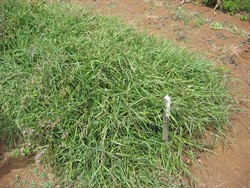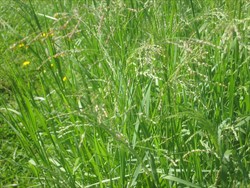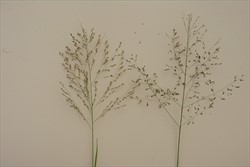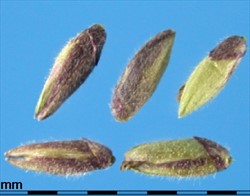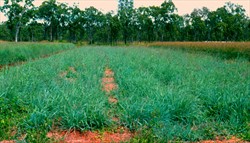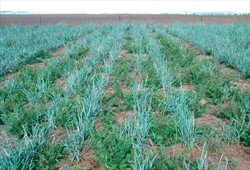Panicum coloratum
Tropical Forages
Panicum coloratum L.
Subordinate taxa:
Panicum coloratum L. var. makarikariense Gooss.
Panicum coloratum L. var. coloratum
var. makarikariense: Panicum makarikariense (Gooss.) Rensb.
var. coloratum: Panicum swynnertonii Rendle
Family: Poaceae (alt. Gramineae) subfamily: Panicoideae tribe: Paniceae subtribe: Panicinae.
A highly variable species, in the P. coloratum - P. stapfianum complex, with types varying in appearance from small and fine to large and robust. A shortly rhizomatous, tufted (erect, geniculate or decumbent) perennial, sometimes with long spreading stolons; stems 2‒4 mm in diameter, and culms 0.3‒1.5 m tall at maturity; culm-nodes glabrous, rarely pubescent. Foliage mostly 20‒70 cm tall; ligule a ciliate membrane sometimes reduced to a ring of short hairs; leaf-blade base simple, broadly rounded, cordate or auriculate; leaf blades glabrous to pilose, 5‒40 cm long and 4‒14 mm wide, varying in colour from green to glaucous blue-green; apex acute, or acuminate. Panicle open, erect or nodding, 6‒30 (‒40) cm long, the lower branches mostly single, occasionally paired, rarely whorled, appressed, ascending, or spreading; spikelets green and purple, 2‒3 mm long, obtuse or subacute. 0.8‒1.4 million seeds per kg.
var. coloratum: green leaves, most widely distributed variety. Kabulabula type, a robust ecotype from Botswana and Namibia, often forming a whorl of 2‒3 lowermost branches in the inflorescence, is somewhat intermediate between the two varieties, but is usually included in var. coloratum.
var. makarikariense: bluish green, glaucous, usually fleshy leaves with strong white midribs.
Africa: bamboeskweek, blousaadgras, bont panicum, buffelgras, buntes hirsegras, kleinbuffelsgras, miergras, osgras, witbuffelgras (Afrikaans); osseiba (Arabic); laabbesa (Gabra, Kenya); agar, gialbo, gurgurro, jalbo, medu (Somalia); gasaba (Sudan)
English: blue panicgrass, coloured guinea grass, small buffalo grass, small panicum, white buffalo grass; coolah grass (Australia); klein grass, kleingrass, klinegrass (USA); keria grass (Kenya)
Europe: boeffelgraes (Danish); buffelgras (Dutch); puhveliheinä (Finnish); hijé, herbe aux bisons (French); Büffelgras, Bisongras, buntes Guineagras (German); buffelgräs (Swedish)
Latin America: colonião azul (Brazil); kleinpanic, mijo perenne, pasto klein (Argentina); klein, zacate aabaya, zacate barqueño, zacate berqueno, zacate colorado, zacate surbana (Mexico); grama zaina, gramalote, guinea fino, guinea pajarito, hierba de bufalo, hierba de guinea, hierba india, murumbu, paja guinea carorena, pasta colorado, pasta indio, pasto sabays, surbana, pasto bufalo, pasto colorado (Spanish)
English: makarikari grass, makarikari panicum; sweetgrass (USA)
Latin America: capim macaricam (Brazil); macaricari (Spanish)
var. coloratum
Native:
Africa: Angola; Botswana; Cameroon; Egypt; Ethiopia; Kenya; Malawi; Mozambique; Namibia; Somalia; South Africa (Cape Province, Free State, KwaZulu-Natal, Transvaal); Sudan; Swaziland; Tanzania; Uganda; Zambia; Zimbabwe
Cultivated/naturalized:
Asia: China
Australia: NSW, Queensland, Victoria, WA
Northern America: Arizona, Oklahoma, Texas (s) (USA)
South America: Argentina
var. makarikariense
Native:
Africa: Botswana; early collections were made in Zimbabwe on the Nata River that flows into Botswana.
Cultivated/naturalized:
Australia: NSW (n), Queensland (s)
Soil requirements
Found on sandy or clay soils in river beds, drainage courses, around pans or in depressions. Var. coloratum occurs mainly on seasonally waterlogged soils, rarely on heavy clays that are waterlogged for long periods. Var. makarikariense, originally collected from the Makarikari (now Makgadikgadi) Salt Pans and adjacent areas, where it occurs on seasonally waterlogged or flooded heavy clays, often with significant salinity, includes types that can produce up 50% maximum yield at an EC of 16.4 dS/m. Salt tolerance varies among genotypes (see 'Klein Verde'). While some types have been collected on low fertility soils, cultivars of both varieties have largely been selected for performance on fertile soils.
Moisture
Var. coloratum originates in areas with annual rainfall from 600 to 1,200 mm, and var. makarikariense from about 500 to 700 mm. The former is cultivated in areas with rainfall from 500 to 1,500 (‒2,000) mm. The latter is mostly sown on seasonally wet or flood-prone soils, and on heavy clays in areas receiving 400‒1,000 mm rainfall. The species is drought tolerant by virtue of its deep fibrous root system, and its ability to grow on flood plains (where soil moisture is comparatively long-lasting). Var. makarikariense has a high tolerance of flooding similar to Setaria sphacelata and Paspalum plicatulum.
Temperature
In the wild, var. coloratum occurs over a wide range of temperature regimes (c. 1‒26 °C), from 30° N to 33° S, and at elevations from sea level to 2,000 m. Var. makarikariense occurs around 20° S and 1,000 m asl, an average annual temperature of about 22 °C. It is difficult to generalise with such a diverse species, but some types, at least, start growth earlier in the spring and continue later into the cool season than do many warm season grasses, providing moisture is available. Frost survival varies with genotype, 'Pollock', 'Burnett' > 'Bambatsi' (at terrestrial temperatures of -10 °C), and 'Selection 75' > 'Verde'.
Light
Both varieties prefer full sun, occurring naturally in open grassland and bushveld.
Reproductive development
Flowers through much of the growing season, but most rapidly in long days of 16 h and at day temperatures of 27‒30 ºC.
Defoliation
Withstands heavy grazing once established, but should be grazed lightly during establishment as it develops more slowly than, for example, Megathyrsus maximus and Chloris gayana .
Fire
Survives annual burning, although this is not a common practice in most areas where it is grown.
Guidelines for establishment and management of sown forages.
Establishment
Germination should be tested prior to sowing, since high levels of dormancy that can last from 3 to 6 months in var. coloratum and up to 3 years in var. makarikariense without treatment, are not uncommon. As with other panicoid species, germination can be improved by removal of glumes. It can be planted vegetatively and from seed. Shy-seeding, stoloniferous varieties such as 'Bushman Mine' are normally planted vegetatively, using rooted cuttings, which are planted on a 60‒90 × 60 cm spacing. Seed can be broadcast on the surface or sown in rows using a sowing rate of 2‒4 kg/ha. Although seedlings can emerge from seed placed to 10 cm in lighter soils, it is safer to sow at 1‒2 cm. Row spacings of up to 90 cm apart are used for rain-grown stands and 30‒45 cm under irrigation. Rolling after sowing improves establishment. Rolling before sowing to compact the seedbed can also be valuable in heavier soils, which have less tendency to crust if rolled prior to broadcasting and lightly covering the seed with harrows. Panicum coloratum is generally slow to establish, competing relatively poorly with weeds and other pasture species during early growth. In warmer environments, early or late wet season sowing is therefore preferred, to avoid competition from vigorous mid-season weed growth. In cooler subtropical environments where early sowings may encounter competition from spring weeds, it is best to sow when there is the greatest probability of experiencing several consecutive days of rainy weather.
Fertilizer
Panicum coloratum grows best on fertile soils. Linear responses to nitrogen applications up to 450 kg/ha have been recorded in some cultivars but not in others. However, it is generally not as responsive to N as is Chloris gayana.
Compatibility (with other species)
Grows well with legumes and other grasses, but may be selectively grazed if associated with less palatable species such as Setaria incrassata.
Companion species
Grasses: Chloris gayana, Setaria incrassata, Bothriochloa insculpta.
Legumes: Clitoria ternatea, Desmanthus spp., Desmodium uncinatum, Macroptilium atropurpureum, M. lathyroides, Medicago sativa, annual Medicago spp., Neonotonia wightii, Trifolium subterraneum, Vicia villosa subsp. varia.
Pests and diseases
No significant pests or diseases. Recorded as being susceptible to maize streak monogeminivirus. A species of cyst nematode, Heterodera goldeni, has been identified on Panicum coloratum in Egypt.
Ability to spread
Seeding ability and stolon development influence spreading ability in P. coloratum. Stoloniferous types (e.g. 'Burnett', 'Pollock' and 'Bushman Mine') tend to have poor seed-setting ability, and any spread is by virtue of stolons. Conversely, freely seeding varieties have good colonising and spreading ability (e.g. klein grass). 'Bambatsi', although a better seeding form of var. makarikariense, is still a relatively poor seeder and does not spread readily in the paddock.
Weed potential
Low.
Nutritive value
CP levels vary from 5 (mature) to 19% (fresh, early season) depending on age of regrowth and fertility of the soil; average IVDMD of 3- and 6-week regrowth is about 60%. CP levels decline on average 4% units, and in vitro digestibility, 13% units, from 4 to 10 weeks. P levels in 12-week old regrowth commonly range from 0.15 to 0.2 (av. 0.18)%, Ca from 0.5 to 1.0 (av. 0.7)%, and Na from 0.2 to 0.4 (av. 0.27)%.
Palatability/acceptability
The species is generally very palatable, although those varieties that exhibit intense flowering are less attractive to livestock. As with most tropical grassesm, its palatability declines as it matures.
Toxicity
Photosensitization has occurred in sheep, goats, cattle and horses grazing either var. coloratum or var. makarikariense pastures, but the condition is rare. Saponins in the grass are assumed to be the cause of the formation of crystalloid substances in the biliary system that subsequently obstruct the bile duct and cause secondary photosensitization. Deaths due to liver failure have been encountered. Sheep appear to be more vulnerable to this condition, which is mostly brought on under hot humid conditions, than are cattle. Sheep, particularly lambs, in stressed condition as after shearing or transport, are the most susceptible, particularly if placed on early regrowth following a dry period. There is also a report of goitre and deformity in lambs born to ewes grazing P. coloratum, ascribed at the time to sub-clinical levels (51 ppm) of HCN in the grass.
Dry matter
Yields of 8‒23 (commonly about 12) t/ha DM have been recorded from both varieties, depending on genotype, cutting regime, soil fertility and available moisture.
Animal production
No information available.
2n = 18, 36, 54 (standard diploid, tetraploid and hexaploid); there are also irregular chromosome complements of 32, 44, and 56. The species is predominantly cross-pollinated, although crossing between var. coloratum and var. makarikariense is limited. There is some evidence of apomixis in some forms, judging by the uniformity of the line. Despite the variability of morphological characters, there is very little agronomic variability among accessions of var. makarikariense. Breeding and selection programs for seed size and reduced dormancy have been undertaken in Texas, USA.
Five distinct morphological groups based on chromosome number and flowering behaviour have been proposed (Pritchard and DeLacy, 1974):
Type A (36 or 45 chromosomes): var. makarikariense - robust, usually semi-procumbent, stoloniferous; has blue-green and glaucous leaves with a white midrib.
Type B (2n = 4x = 36): Kabulabula form (var. coloratum) - robust type, erect, bright green in colour.
Type C (54 chromosomes): var. coloratum, fine stems and green or blue-green leaves.
Type D (36 or 45 chromosomes): var. coloratum, also with fine stems and green or blue-green leaves, normally with red nodes.
Type E (2n = 2x = 18): small stature, very fine stems and leaves, small panicles.
Crops are capable of producing 100‒180 kg/ha of seed rain-grown, and up to 400 kg/ha irrigated. However, seed matures unevenly over a long period (well in excess of 15 days) with no peak maturation, and shatters as it matures. At 100% maturation virtually all the seed has been shed. Different harvest methods may be adopted to improve efficiency of collection. Direct heading will yield about 20‒25% of the seed; cutting with a reaper and binder, drying under cover and subsequently threshing, about 40%; cutting with a reaping hook, drying in the field and threshing, about 50%; and collecting seed several times by hand shaking about 60% of possible seed yield. As a generalisation, seed should be harvested at 22‒25 days after anthesis to optimise both seed quantity and quality. Maturation and dehiscence are improved by allowing seed to sweat in windrows or 15‒25 cm heaps for two days prior to drying.
Tolerant of pre-emergent application of propazine and triasulfuron, and post-emergent propachlor, metolachlor, and triasulfuron, but susceptible to atrazine, ametryne, prometryne, propazine, linuron, pendimethalin, alachlor, metolachlor, propachlor, metsulfuron methyl and imazapic. Tolerant of post emergent application of propazine, metsulfuron methyl and triasulfuron but not other herbicides. Susceptible to 2,4-D and dicamba up to 5-leaf stage, but relatively safe in established swards. Established stands are also tolerant of picloram, but rates should be checked.
- Well adapted to heavy, self-mulching, black clay soils.
- Tolerant of temporary waterlogging and flooding.
- Tolerant of drought.
- Tolerant of moderate soil salinity.
- Very persistent once established.
- Cold tolerant.
- High forage quality.
- Lower N requirement than Megathyrsus maximus.
- Slow to establish.
- Poor cool season growth.
- Seed shattering reduces seed harvests.
Bogdan, A.V. (1977) Tropical Pasture and Fodder Plants. Longman Inc., New York, USA. p. 175–181.
Bryant, W.G. (1966) Interim Assessment of Introduced Plants - No. 1. Panicum coloratum. Plant Introduction Review 3:18–33.
Gibbs Russell, G.E., Watson, L., Koekemoer, M., Smook, L., Barker, N.P., Anderson, H.M. and Dallwitz, M.J. (1990) Grasses of Southern Africa: An identification manual. Memoirs of the Botanical Survey of South Africa No. 58. Botanical Research Institute, Pretoria, South Africa.
Lloyd, D.L. (1981) Makarikari grass - (Panicum coloratum var. makarikariense) - a review with particular reference to Australia. Tropical Grasslands 15:44–52. bit.ly/345p9Qv
Lloyd, D.L. and Hilder T.B. (1985) Dry matter production by a subtropical grass (Makarikari grass grown in association with a temperate annual legume (barrel medic) and nitrogen fertilizer in southern Queensland (Australia). Australian Journal of Experimental Agriculture 25:54–60. doi.org/10.1071/EA9850054
Pritchard, A.J. and Lacy, I.H.D. (1974) The cytology, breeding system and flowering behaviour of Panicum coloratum. Australian Journal of Botany 22:57–66. doi.org/10.1071/BT9740057
Sugiura, N., Kato, M. and Inami, S. (1992) Studies on cultivation of new cultivars of colored guineagrass "Tamidori" and "Tayutaka". Effects of seeding time, cutting frequency, amount of fertilizer application and seeding pattern on the growth and yield. Research Bulletin of the Aichi-ken Agricultural Research Center 24:69–75. bit.ly/39wvDsH
Tischler, C.R. and Ocumpaugh, W.R. (2004) Kleingrass, blue panic, and vine mesquite. In: Moser, L.E., Burson, B.L. and Sollenberger, L.E. (eds) Warm-Season (C4) Grasses. Agronomy Monograph No. 45. ASA, CSSA, SSSA, Madison, WI, USA. p. 623–649. doi.org/10.2134/agronmonogr45.c18
var. coloratum
'Bushman Mine' (APG 54661) Released in Zimbabwe & Botswana. Origin Botswana, a strongly stoloniferous, drought-hardy perennial, with roots to a depth of 1.8 m or more; intermediate between var. coloratum and var. makarikariense. Grows best on heavier soils, and has some tolerance of waterlogging. It is slow to establish, but is highly productive in subsequent years. It is very palatable and is suitable for permanent pastures. A poor seed producer, it is usually planted by rootstock or stem cuttings. Mixes well with legumes, makes good hay and responds well to nitrogen.
'Nakuru' (CPI 16796) Released in Kenya. Kabulabula type, intermediate between var. coloratum and var. makarikariense. A tall variety, with whorl of 2 or 3 lowermost branches in the panicle. Has good cool season growth, but poor frost tolerance. Seeds freely.
'Selection 75' or 'Kleingrass 75' (PI 166400) Released in Texas, USA (1969). Origin Cape Province, South Africa. A fine stemmed, leafy bunchgrass, with green or greenish-grey leaves, and growing to about 1 m tall. Grows well on sandy to clay soils from south Texas to Oklahoma. It is drought tolerant, and grows earlier in the spring and later in the fall than many warm season grasses. Supports good animal gains and tolerates heavy utilisation. Sheep and goats grazing 'Kleingrass 75' have developed swellhead (photosensitisation) at times.
'Solai' (PI 255333) Released in Kenya. Selected from Kenya ecotype. Not aggressive, growing well with legumes. Seeds freely. Hexaploid.
'Verde', 'Klein Verde' (PI 483444) Released in Texas, USA (1981). Approximately 4,000 individual kleingrass plants originating from 30 plant introductions from Africa were screened for seed size (weight). Selected plants and their progeny from open pollinated seed were established in the field and evaluated for seed size. The superior plants in this nursery were selected as the parents for 'Verde' and were intercrossed in an isolated crossing block. 'Verde' seeds are 20‒25 percent heavier than 'Kleingrass 75' seed, and seedling growth is 20‒60 percent faster for up to 30 days after emergence. Less affected by salinity than is 'Bambatsi'. Forage production and quality are similar to those of 'Kleingrass 75', although it is a little less winter-hardy.
'Tamidori' Released in Aichi, Japan (1986). Selected from hexaploid cultivar, 'Solai', by three generations of maternal selection. It germinates well and has good early season growth at lower temperature (15‒20 ºC), and is adapted to poorly drained soils. Dry matter yield is c.10% higher than that of 'Solai'.
'Tayutaka' Released in Aichi, Japan (1990). Selected from Kabulabula type, it originates from 10 genotypes, selected over three generations of maternal and/or mass selection. It has wider leaves and larger stolons, and flowers 1‒2 weeks later than 'Tamidori'. Dry matter yield is 5‒7% higher than that of 'Tamidori'. Produces good early season growth and is more tolerant of waterlogging than 'Tamidori'.
var. makarikariense
'Bambatsi' (CPI 13372) Released in Zimbabwe (late 1940s) and Australia (1958). Origin Bambatsi Pan on the Manzamnyama/Nata River in Zimbabwe. An erect, tussocky, shortly rhizomatous (seldom stoloniferous), dark-seeded form, fertile culms 1.5‒1.8 m tall, distinguished from most other such forms by its superior seed set. About 95 percent of the population have the erect habit, about 5 percent have the more spreading and stoloniferous habit described for 'Pollock'. Slow to establish, but tolerates flooding and is the most frost-tolerant cultivar. Makes no growth during winter but recovers better than Megathyrsus maximus cv. Petrie after winter. Stands waterlogged conditions as well as 'Pollock' and has a reasonable degree of drought tolerance. Commercial 'Bambatsi' in Australia is derived from a mixture of 'Bambatsi', 'Burnett' and 'Pollock', which with cross-breeding; has produced a variable but tough and resilient cultivar.
'Burnett' (Q 3510) Released in Australia (1962). Origin Botswana. A tussocky, semi- erect type to 1.4 m tall, with greater ability to spread from the lower nodes than 'Bambatsi', being intermediate between 'Bambatsi' and 'Pollock' in stolon development, having about half the population stoloniferous. Seed is dark like that of 'Bambatsi'. Some frost tolerance and slow winter growth although new tillers produced if moisture is available. Seed ripens unevenly and shatters badly. Not commercially available.
'Pollock' Released in Australia (1961). Institutional accession from South Africa, "Makarikari No. 2 1947, Rietvlei". Tussock to 1.2 m tall; more stoloniferous/rhizomatous than 'Bambatsi' and 'Pollock'. Leaves slightly smaller than those of 'Bambatsi'. Inflorescence denser than 'Bambatsi'. In spaced swards, it develops crowns 90‒180 cm in diameter, which is useful for soil conservation, particularly in areas subject to waterlogging. More frost-tolerant than 'Bambatsi' if grazed heavily in the autumn. Seed ripens unevenly and shatters badly, as in 'Bambatsi', but yield is half that of 'Bambatsi'. Not commercially available.
'Prinshof 11/12' Similar to 'Bambatsi', but does not seed as freely.
'Zhilo' (PI 295648, CPI 28274) Released in South Africa (pre-1960). Creeping panicum. From the sandy banks of the Shashi River, opposite Zhilo Hill, Zimbabwe. Similar to 'Prinshof strain 14/12', but with thicker, more succulent stems. When grown widely spaced, individual plants may reach 2 m diameter. Low seeding variety.
ATF 714 (APG 55594) Selected in Queensland, Australia. Origin Limpopo, South Africa (23.5º S, 260 m asl, rainfall 450 mm). Low growing, stoloniferous type, adapted to low P soils and heavy grazing.
ATF 3957 (APG 55524) Selected in South Africa. A reselection of kleingrass (probably 'Selection-75') from USA, to reduce variability.
PI 559908 (TEM-LD1) Selected in Texas, USA for low post harvest seed dormancy. Germination of freshly harvested seed 89%. Morphologically indistinguishable from 'Selection-75', the cultivar which comprised 75% of base population. Produces abundant fertile seed in late spring, (av. mass 0.82 mg/seed). Spring growth initiated in early March; plants bloom by mid-May in N hemisphere subtropics.
PI 564168 (TEM-SR1) Selected in Texas, USA for reduced seed shattering. Leaves wider and stems greater in diameter than those of 'Selection-75' and more upright growth habit than 'Selection-75' and 'Verde'; also lower DM yields than these cultivars. Retains over twice the number of seed per inflorescence at 35 days after flowering, and produces more seed (av. mass 1.00 mg/seed) per inflorescence than does 'Selection-75'.
PI 573097 (TEM-SV1) Selected in Texas, USA for improved seedling growth rate. Morphologically indistinguishable from 'Selection-75'. Seedlings grow faster than those of 'Selection-75', having 33% and 20% greater shoot dry mass at 16 and 30 days after emergence in field evaluations. Seeds have greater carbohydrate reserves than those of 'Selection-75' and an average mass of 0.93 mg/seed.
